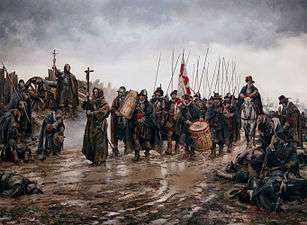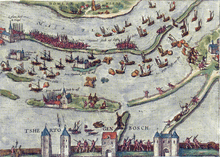Battle of Empel
The Miracle of Empel (Milagro de Empel in Spanish) was an unexpected Spanish victory on 8 December 1585 near Empel, in the Netherlands, as part of the Eighty Years' War, in which a surrounded Spanish force miraculously won against an enemy who exceeded them in number.

The battle
After the campaign of 1585, the Governor of Spanish Netherlands and commander of the Spanish troops Alexander Farnese, Duke of Parma decided to go into winter quarters on Northern Dutch territory. The troops of Karl von Mansfeld occupied the area around 's-Hertogenbosch. Some 3000-4000 men of the Spanish Tercio, including Juan del Águila, under Maestre de Campo Francisco Arias de Bobadilla were stationed on Bommelerwaard, which was supposed to be rich enough to support these troops through the winter. But all farmers had left the island, taking their livestock with them.
To make the situation of the hungry Spanish troops even worse, Dutch commander Philip of Hohenlohe-Neuenstein arrived with a strong land force and 100 ships. The Dutch leader offered an honorable surrender to the Spaniards but the response was resolute: «Los infantes españoles prefieren la muerte a la deshonra. Ya hablaremos de capitulación después de muertos.» (English: "Spanish soldiers prefer death to dishonor. We will talk about surrender after death"). Philip of Hohenlohe-Neuenstein breached the dikes of Bommelwaard, forcing the Spanish back over the Rhine to Empel. There they were unable to reach 's-Hertogenbosch, because the terrain was flooded and guarded by the fleet of Hohenlohe. The island was attacked as well by artillery fire coming from a fort, at the other side of the river.

The situation for the Spanish looked desperate. A Spanish soldier who was digging a trench around the church commented "this is more likely to be my grave than a trench". As he dug, he found a painting representing Mary of the Immaculate Conception. Bobadilla interpreted the discovery as a sign from God, and had the painting put on the Spanish flag for worship.
That night, a sudden further drop in temperature started to freeze the shallow waters of the flooded lands. This made possible for the Spanish troops to attack the rebels and burn their ships. Admiral Hohenlohe-Neuenstein supposedly responded by saying: "It seems that God is Spanish to work such a miracle for them".
That same day, Mary of the Immaculate Conception was proclaimed patroness of the Spanish Tercios of Flanders and Italy.
In the 19th century
On 8 December 1854 Pope Pius IX defined the dogma of the Immaculate Conception of the Blessed Virgin Mary. In 1892 Maria Cristina of Austria (Maria Christina Désirée Henriette Felicitas Rainiera von Habsburg-Lothringen, und Österreich), Queen Regent of Spain, proclaimed Mary of the Immaculate Conception patroness of the entire Spanish Infantry.
External links
- (in Dutch) Article on the site of the Army Museum of The Netherlands